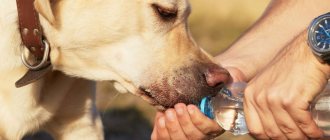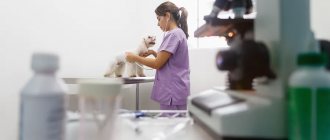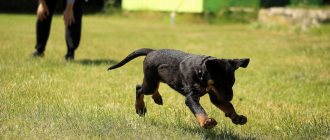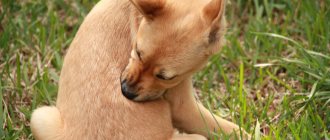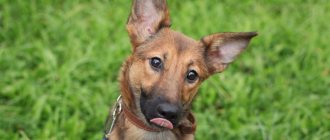Why does a dog refuse to drink?
Dogs must maintain adequate hydration status
, so a dog's refusal to drink water is a cause for concern. You should expect your pet to drink water freely and enthusiastically several times a day.
- If your dog doesn't drink for a day or more and turns his head away when offered water, there is likely a health problem.
- Animal aging
- Polluted water
- Dehydration
- Urinary tract infection
- Oral diseases or injuries
- Water is a basic requirement for maintaining health.
Dogs that don't drink for more than one day
, may become dehydrated, which is a dangerous condition that may require veterinary attention. Why does refusal to drink occur in sick dogs? Drinking water is the cornerstone of any dog's health, and disruption to normal drinking patterns can indicate a wide range of problems. It is not normal for a pet to refuse to drink.
Warning signs
When organizing a balanced diet for an animal, 24-hour access to water is a prerequisite. The water should be changed daily. It’s good if the owner, when changing the water, notices a decrease in the level relative to the original amount.
But, as a rule, water replacement is carried out mechanically and deviations in the pet’s condition are already noticed by the changed behavior.
The main signs that may indirectly indicate a pet is dehydrated include the following:
- loss of appetite;
- loss of interest in life, lethargy, apathy;
- dull look;
- sunken eyes;
- red eyes.
Dehydration
If your pet is panting or drooling more than usual, has red, dry or sticky gums, a fever, heat, trouble with normal coordination, or skin that doesn't retain its normal moisture and elasticity, your dog may be suffering from dehydration.
Strangely, the more dehydrated a dog is, the less interested he is in water.
Dehydration can be a sign of pancreatitis, which is inflammation of the pancreas. Pancreatitis can be caused by fatty or irregular feeding, obesity or diabetes.
Diagnostics
Blood tests, such as a complete blood count and chemistry panel, are important to try to find the underlying cause of dehydration, but may not show the presence of dehydration itself.
The most important tests are hematocrit and total blood protein. These tests can show whether dehydration is present: if the hematocrit and total protein are increased, dehydration is present.
Determining urine concentration can also help determine whether an animal is dehydrated or has kidney damage.
Illness or injury
Although any illness can interfere with a dog's normal intake of food and water, urinary tract infections and oral injuries can, in exceptional cases, keep a dog away from water.
Urinary tract infections usually start in the urethra and then spread to the bladder, sometimes even infecting the kidneys. If your dog doesn't have normal urination, such as being unable to stand to urinate, holding urine, having a compromised immune system, or having abnormally concentrated urine, he is more likely to develop urinary tract problems.
The infection can lead to bladder and kidney infections.
Urinary tract infections are more common in female dogs, especially older ones.
Symptoms include more frequent urination, urinating in the house, painful urination, and blood in the urine. The pain of a urinary tract infection may cause your dog to refuse to drink water.
Nausea
There are some medical conditions that can cause nausea in dogs, and nausea can cause your dog to drink less.
Kidney disease often causes increased thirst in the early stages. However, as the disease progresses and kidney enzyme levels rise, dogs often begin to vomit. This nausea can lead to decreased appetite, decreased thirst, and possibly even vomiting.
Conditions that cause inflammation of the gastrointestinal tract, such as pancreatitis and gastroenteritis, can also cause nausea.
If you notice changes in your dog's thirst that are also accompanied by decreased appetite, vomiting, or diarrhea, have your dog examined by a veterinarian as soon as possible to determine and treat the underlying cause.
Oral diseases
Damage to the mouth may include periodontal disease, tooth root abscess, luxated or fractured jaw, loss of sensation, or cancer. Periodontal disease is a bacterial infection of the mouth that is very common. Periodontal disease and tooth root abscess are typically associated with poor oral hygiene, while tooth root abscess, luxation, loss, or fracture occur due to dental trauma. Oral cancer is the abnormal growth of a tumor in the mouth. Cancer can occur in dogs of any age, but is more common in older dogs.
Dangers of not eating and drinking
Exhaustion and dehydration are conditions that are dangerous to the health and life of animals.
They affect the body as follows:
If the reason is related to health, then you need to show the dog to a veterinarian as soon as possible.
What to do if your dog refuses to drink?
Every dog should drink water several times a day.
This is one of the most necessary things for a dog's health. If your pet refuses to drink, your goal should always be to get the dog to resume drinking, but your tactics will vary depending on the suspected cause.
Problems with aging and clean water can usually be addressed with common sense, but dehydration, urinary tract infections, and oral diseases and injuries require immediate veterinary evaluation. If the pet is elderly, you will need to be more proactive in making sure your dog drinks water regularly.
Age is not experienced the same way by every dog; for example, large dog breeds tend to age faster than small dogs. If your dog is between 5 and 10 years old and is having increasing difficulty with normal movements, less tolerance for normal physical activity, and more health problems of all kinds, then he may be geriatric. A geriatric dog should be kept close to the water, with ample opportunity to drink and be monitored more closely.
To avoid water contamination, always make sure your dog's water is clean and fresh. Wash your dog's water bowl daily and refill it with clean water at least once a day.
While a dehydrated dog should drink water, it may also require more advanced interventions. You can try feeding your dog cool water. If the pet still shows signs of distress, she should be examined by a veterinarian.
Under the supervision of a veterinarian, the dog may receive fluid therapy, such as subcutaneous injection of lactated Ringer's solution. Pancreatitis may require intravenous fluid therapy, medications to prevent vomiting, a low-fat diet, and long-term monitoring of the dog's condition.
Urinary tract infections require immediate veterinary attention. If left untreated for a period of time, they can invade the bladder and possibly even the kidneys. They are treated with antibiotics. The tumor will require surgical removal. Sometimes a dog can develop a recurrent condition, where the infection becomes resistant to the antibiotic or comes back again. In this case, your dog may be prescribed long-term, low-dose antibiotics.
Dogs with oral pathology should also be under veterinary supervision and receive medical attention. To reduce the risk of pancreatitis, avoid fatty foods and maintain a stable and balanced diet for your dog. To avoid injury to your dog's teeth and mouth, avoid chewing on sticks or other objects as they may break in your dog's mouth. Provide safe chew toys and have your dog's teeth cleaned regularly by a professional.
To detect oral cancer early, examine your dog's mouth frequently for any abnormalities such as swelling, lumps, growth, and discoloration.
^Top
The dog does not eat regular food well, but eats grass on walks.
One of the sometimes not very clear food manifestations in dogs is eating grass while walking. Many owners observe this in their pets. This always causes confusion and questions.
The reasons for this phenomenon lie in the characteristics of nutrition and digestion. Dogs' ancestors were carnivores, but the digestive system subsequently evolved. The dog has become a more omnivorous animal. In addition to the main part of nutrition - meat - she began to require sources of dietary fiber and carbohydrates. These are vegetables and grains processed by humans into digestible forms. But the evolutionarily ancient habits of the carnivorous diet of our ancestors remained to cleanse their stomachs of indigestible by-products. Such as feathers, wool, bone fragments. Such inedible things can remain in the stomach for a long time, causing discomfort. Hence the habit of systematically cleaning the contents of the stomach.
The main reasons for eating grass:
- Relief from stomach discomfort, nausea and pain. With digestive disorders, the dog does not eat its usual food well, but at the same time tries to cleanse the stomach with grass.
- Elimination of blockages, stagnant accumulations and foreign bodies in the stomach. Eating grass causes a gag reflex.
- Excessive stress, accompanied by increased tone and intestinal spasms, and sometimes bloating and constipation. In humans, a similar disorder is called irritable bowel syndrome. Only a person is treated with antispasmodics, and a dog alleviates its condition by eating grass.
- The presence of medicinal properties in some types of grass. Eating such herbs is typical only for wild individuals or those raised near humans, but in natural conditions over a number of generations.
- Playful behavior, with puppies and juveniles tearing grass with their teeth, but not eating it.
It is believed that a dog should not stop eating grass. Because it might benefit her. But one thing should be remembered. The grass eaten is not everywhere and may not always be clean and safe. In some places, it may be treated with harmful pesticides, fertilizers or other agricultural pesticides. Accidental eating of plants in natural areas that are also poisonous to dogs also happens. Therefore there is a risk of poisoning. Anemone, sedum, marigold, and buttercup are toxic to dogs. By the way, some indoor plants are also poisonous - dieffenbachia, monstera, oleander. The way out is seen in strictly defined and safe places for “grazing”. Some gardeners sow wheatgrass, wheat, and oats on their own for their pets. Decorative dogs are able to eat grass from a durable, stable box or flower pot. This kind of weed is also available in pet stores.
Therefore, if your dog is not eating or drinking well, there is cause for concern. Since a whole range of reasons for this can be identified. And some of them may require emergency veterinary care.
Yagovitin M.Yu.
Good to know
- Dog breathing problems?
- Why does my dog often vomit yellow or white foam?
- Why doesn't the dog eat anything? The dog doesn't eat?
- Why does a dog scratch its ears and shake its head?
- The reason why your dog constantly whines?
- Why is my dog breathing heavily and frequently?
- Why does a dog eat cat feces?
- Why does a dog drink a lot of water?
- Eye discharge in dogs
- Why does a young dog have bad breath?
- Why does a dog lose hair?
- Why does my dog have diarrhea? Dog diarrhea
- How to treat bartonellosis in dogs
- Bordetelosis and Bordetella in dogs
- How to treat adenovirus in dogs?
- Why is the dog lethargic?
On the road
On the road, it is not always possible to find suitable water for your pet, and it is impossible to leave him without it. Drinking from your hands is a bad idea; almost all the water will spill on the ground. For such cases, a simple invention was invented - a road drinker.
They are usually made of lightweight plastic and are cheap and practical. The plastic bottle can be replaced, the cap is of standard sizes, there are also caps with dispensers - this will make it more convenient to use, and the dog will not spill anything. Drinking bowls are sold at pet stores.

